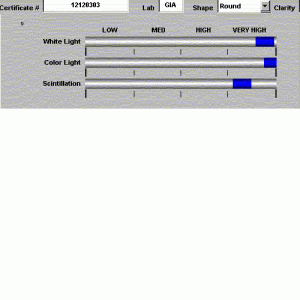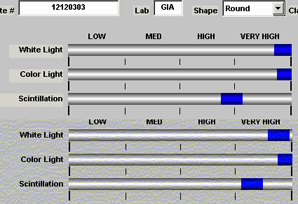niceice
Brilliant_Rock
- Joined
- Jan 29, 2003
- Messages
- 1,792
We are often asked why we do not offer Brilliance Scope (BS) results on our diamond details pages which happen to be quite detailed. We thought that our reason for not doing so might be of assistance to people on this forum regarding the diamonds that they are considering...
The reality is that the accuracy of the Brilliance Scope relies heavily on the ability of the user to accurately calibrate the machine and scan the diamonds being scanned in a consistent and impartial manner.
The reality is that many of the internet dealers who have promoted the use of the BS have had their machines taken away by Gem Ex for over-calibrating their machines so that their diamonds would score higher than they would if measured on a correctly calibrated machine.
The reality is that many of the internet dealers who have had BS machines were caught re-scanning diamonds that scored Very High and entering the information for other diamonds in their inventory that did not score well so that those diamonds would appear to be better than they are...
The reality is that we feel that these types of events damage the integrity of the machine and that by promoting the use of the machine that by using the machine ourselves and thus promoting the use of the machine, that we would be unwillingly promoting the consumer fraud being perpetrated by these other companies.
who have no reason to see one diamond score higher than another... As we understand it, GemEx hopes to have all machines in retail use picked up by October of this year. We want to congratulate GemEx for taking this bold step to maintain the integrity of their product!!!
as diamonds can be sent to either source for independent and accurate results. We know that RockDoc can tell many stories regarding diamonds that supposedly scored Very High according to the results published by the internet dealer selling the stone only to score poorly when he scanned the stone using a properly calibrated machine... No doubt other independent gemological laboratories will soon join the list of laboratories offering independent and impartial Gem Ex Brilliance Scan services, we look forward to adding them to the list of companies providing this service...[/u][/u][/u]
The reality is that the accuracy of the Brilliance Scope relies heavily on the ability of the user to accurately calibrate the machine and scan the diamonds being scanned in a consistent and impartial manner.
The reality is that many of the internet dealers who have promoted the use of the BS have had their machines taken away by Gem Ex for over-calibrating their machines so that their diamonds would score higher than they would if measured on a correctly calibrated machine.
The reality is that many of the internet dealers who have had BS machines were caught re-scanning diamonds that scored Very High and entering the information for other diamonds in their inventory that did not score well so that those diamonds would appear to be better than they are...
The reality is that we feel that these types of events damage the integrity of the machine and that by promoting the use of the machine that by using the machine ourselves and thus promoting the use of the machine, that we would be unwillingly promoting the consumer fraud being perpetrated by these other companies.
who have no reason to see one diamond score higher than another... As we understand it, GemEx hopes to have all machines in retail use picked up by October of this year. We want to congratulate GemEx for taking this bold step to maintain the integrity of their product!!!
as diamonds can be sent to either source for independent and accurate results. We know that RockDoc can tell many stories regarding diamonds that supposedly scored Very High according to the results published by the internet dealer selling the stone only to score poorly when he scanned the stone using a properly calibrated machine... No doubt other independent gemological laboratories will soon join the list of laboratories offering independent and impartial Gem Ex Brilliance Scan services, we look forward to adding them to the list of companies providing this service...[/u][/u][/u]














300x240.png)